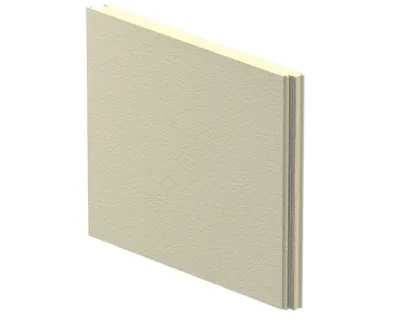


Metl-Span offers a CF Santa Fe embossed insulated metal wall panel that features a flat exterior profile with a raised stucco texture to mirror the appearance of masonry stucco. Stucco-textured metal panels give buildings a Southwestern desert look, making them the ideal panel choice for your stucco wall needs.
Stucco metal wall panels are easy to install, energy-efficient, durable and low-maintenance, contributing to cost-effectiveness throughout the process of selecting, installing and using insulated metal wall panels.
Our Santa Fe panels serve a variety of industries, including automotive, healthcare, manufacturing and self-storage.
24″, 30″, 36″, 42″
PIR
8′-0″ to 40′-0″ Vertical
PUR
8′-0″ to 32′-0″ Horizontal
8′-0″ to 40′-0″ Vertical
G-90 galvanized steel or AZ-50 aluminum-zinc coating in 24 and 22 gauge.
U-factor (BTU/h-ft2*fahrenheit)
Panel width: 42″ at 35 degrees
2″ = 0.058
2.5″ = 0.045
3″ = 0.037
4″ = 0.028
R-value (h*ft2*F/BTU)
Panel width: 42″ at 35 degrees
2″ = 17.9
2.5″ = 22.4
3″ = 26.9
4″ = 35.9
Thermal values, including R-value and U-value, are crucial metrics used in building construction and insulation to quantify the ability of materials to resist heat transfer. Here’s what each means:
1. ** R** value:
– The R-value measures a material’s thermal resistance, indicating its ability to resist heat flow. The higher the R value, the better the insulation.
– It’s a measure of thermal resistance per unit area. So the thicker the insulation (or the higher its thermal resistance), the higher the R-value.
– The R-value is commonly used in the USA and some other countries to specify insulation performance for various building components such as walls, roofs and floors.
– Higher R-values are desirable in colder climates to minimize heat loss in buildings during winter.
2. ** U coefficient**:
– The U-value is the thermal transmittance of a material, indicating the rate of heat transfer through it. The lower the U-value, the better the insulation.
– Unlike the R-value, which measures resistance, the U-value measures the amount of heat that can pass through a material.
– This is the reciprocal of the R-value. So a material with a high R-value will have a low U-value.
– The U-value is commonly used in Europe and other parts of the world to quantify the insulating properties of windows, doors and other building components.
– Lower U coefficients are desirable in hot and cold climates to reduce the amount of heat transferred through building components, thus improving energy efficiency.
In summary, R-value and U-value are complementary metrics used to assess the insulating properties of materials. While the R-value measures thermal resistance, indicating a material’s ability to prevent heat flow, the U-value measures thermal transmittance, indicating the amount of heat that can pass through a material. Both are essential for designing energy-efficient buildings and choosing appropriate insulation materials.
Customized solutions to meet your needs and expectations